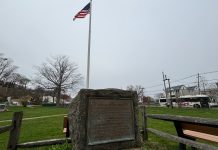By John Burton
Local beach community mayors are re-evaluating their town’s requirements for beach access after the state’s environmental commissioner signed an initiative, forwarded by the Christie Administration.
State Department of Environmental Protection (DEP) Commissioner Bob Martin recently signed off on the initiative proposed by Gov. Chris Christie that goes into effect on Nov. 3. The plan calls for DEP representatives to work with communities to formulate plans that work for towns to ensure the public has access to beaches and waterways.
The DEP will now allow municipalities to draft their own plans on how they will provide access, contingent on DEP approval.
DEP spokesman Lawrence Hajna said the “whole point” to the new requirements is “getting plans tailored to each community.”
“We realized that we had to work out a resolution to this problem that would, instead of using a stick, use a carrot,” Hajna said.
“That would be a welcome relief,” said Sea Bright Mayor Dina Long, given the borough’s long, prickly history with the DEP on the issue.
In the past, Long said the DEP rarely notified the borough about issues involving beach access until the DEP was threatened with lawsuits.
“That’s how they dealt with us on public access in the past,” she said. “So, anything would be a welcome departure from that.”
Sea Bright, she said, has seven public access points to its beachfront as well as access to the Navesink River at the western end of almost all of its cross streets. However, the mayor said providing additional parking and public restroom facilities – as the Corzine administration had sought – would strain the town. She said it was a space problem, “not an access problem.”
Sea Bright officials are drafting a plan for the DEP, she said.
Monmouth Beach Mayor Susan Howard sees this decision as inconsequential for her community.
“We’ve been doing everything we could possibly do to provide access,” she said, including having a rather large free beach area.
The one sticking point for her town, Howard said, is “we can’t create anymore parking.”
John Weber, northeast regional manager for the Surfrider Foundation, a coastal environmental advocacy organization, said his group has concerns about the initiative. The organization doesn’t like the idea that municipalities can draft their own plans.
“What we said from the beginning is we’re talking about the Public Trust Doctrine, what’s suppose to be a right for all people in New Jersey,” for public access, he said. To have it vary from one town to another would seem to contradict the doctrine’s intent and would “open it up to a lot of lawsuits, quite frankly,” Weber said.
The DEP’s Hajna said some municipalities “will have to do a little bit more …and some won’t have to do as much.” All will have to do their part, he stressed.
The administration was looking to turn around what had been installed by the Corzine administration in 2007. Corzine had the DEP enact rules that looked to have those communities provide a 24/7 access to the waterways and make available public restrooms and parking. State funding was to be used as leverage to get towns to comply. When towns sued, claiming the rules were overly burdensome, there were a series of court decisions supporting the towns.
The new plan should help establish new points of public access by offering incentives to local governments to design plans that will address the needs of those towns, according to the DEP.














